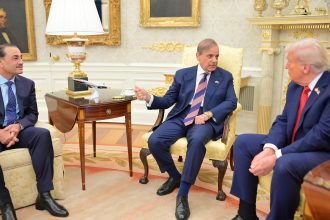In 2025, China’s J-35A stealth fighter, developed by Shenyang Aircraft Corporation (SAC) under the Aviation Industry Corporation of China (AVIC), is reportedly nearing mass production, marking a significant step in Beijing’s push to rival U.S. airpower with a second fifth-generation combat aircraft alongside the Chengdu J-20.
The J-35A, a land-based variant of the carrier-capable J-35, debuted publicly at the 2024 Zhuhai Airshow, showcasing advanced stealth and networked warfare capabilities. Pakistan has emerged as the first potential export customer, with reports of an order for 40 jets, potentially shifting South Asia’s airpower balance.
J-35A’s Development and Production Status
The J-35A, evolved from the FC-31 prototype first flown in 2012, completed its maiden flight as a refined model in 2021, with a land-based variant unveiled in 2023. Defence Security Asia reported that social media images showed a J-35A in zinc chromate green primer, a hallmark of production-stage aircraft flying near SAC’s Shenyang facility, suggesting progress toward mass production.
However, military experts believe that while the jet may enter production by early 2026, it is not yet in active service, with initial operational testing ongoing. Wang Yongqing, SAC’s chief researcher, emphasized the J-35A’s role as a “coordinator” in air defense, capable of locking onto targets and guiding other systems like surface-to-air missiles.
Mass production, defined as large-scale manufacturing post-prototyping, indicates that the J-35A is transitioning from experimental to operational. The aircraft’s modular design, powered by twin Guizhou WS-21 turbofan engines, supports scalability for future variants. Radar-absorbing materials and a reduced radar cross-section enhance its stealth profile.
Pakistan’s Strategic Acquisition
Pakistan announced its intent to acquire 40 J-35A jets, with deliveries potentially starting in early 2026 and accelerated from late 2026, according to Defence Security Asia. Pakistani Air Force (PAF) pilots are reportedly training in China, signalling near-term induction. Air Chief Marshal Zaheer Ahmad Babar confirmed negotiations in 2024, stating the J-35A will join the PAF “shortly.”
The acquisition, driven by the jet’s affordability and twin-engine survivability, could give Pakistan an edge over India’s Su-30MKIs and Rafales, enabling stealth-driven beyond-visual-range engagements.
I can now confidently say the export version of the J-35A, the J-35AE is being rushed for export.😎
The customer is a Muslim majority country. Not saying much beyond that.
For those who likes to speculate, it could be UAE, Qatar, Saudi Arabia, Egypt or Pakistan.
Since Pakistan… pic.twitter.com/23tpwgBk5c
— Zhao DaShuai 东北进修🇨🇳 (@zhao_dashuai) May 23, 2025Capabilities and Strategic Role
The J-35A, designed for air superiority and multirole strike missions, features a V-tail layout, serrated panelling, and an internal weapons bay for PL-15E or PL-17 missiles, maintaining stealth in engagements. Its Active Electronically Scanned Array (AESA) radar and distributed sensors provide 360-degree situational awareness, akin to the U.S. F-35’s networked warfare role. Wang Yongqing noted its ability to counter stealth threats, integrating with China’s air defense network to neutralize enemy fighters and cruise missiles. Compared to the larger J-20, the J-35A offers cost-effective combat mass, potentially replacing older J-10A and Su-27 jets.
First batch of the J-35A stealth fighter flies out of the mass production line.
This is the air force variant, which will be the base airframe for the export version (J-35AE). Just like the relationships between J-10C and J-10CE. pic.twitter.com/mkTPWBOhyM
— Zhao DaShuai 东北进修🇨🇳 (@zhao_dashuai) May 21, 2025While visually similar to the F-35, with diverterless supersonic inlets and stealth contouring, the J-35A’s twin-engine design prioritises survivability over the F-35’s single-engine efficiency. Accusations of espionage, fueled by a 2015 Der Spiegel report on stolen F-35 data, remain unverified, with analysts like Koh suggesting design convergence due to shared stealth requirements.
Regional and Global Implications
The J-35A strengthens China’s anti-access/area denial (A2/AD) strategy in the South China Sea and Taiwan Strait, potentially challenging U.S. and allied air superiority. Its export to Pakistan could reshape South Asia’s military balance, prompting India to accelerate its AMCA program. Egypt’s interest in the J-35A further signals its export potential. However, the jet’s lack of a global support network, unlike the F-35’s, limits its operational flexibility.
As China advances J-35A production, with a carrier-capable variant tested on the Fujian carrier in March 2025, the PLA aims to bolster air and naval capabilities.






